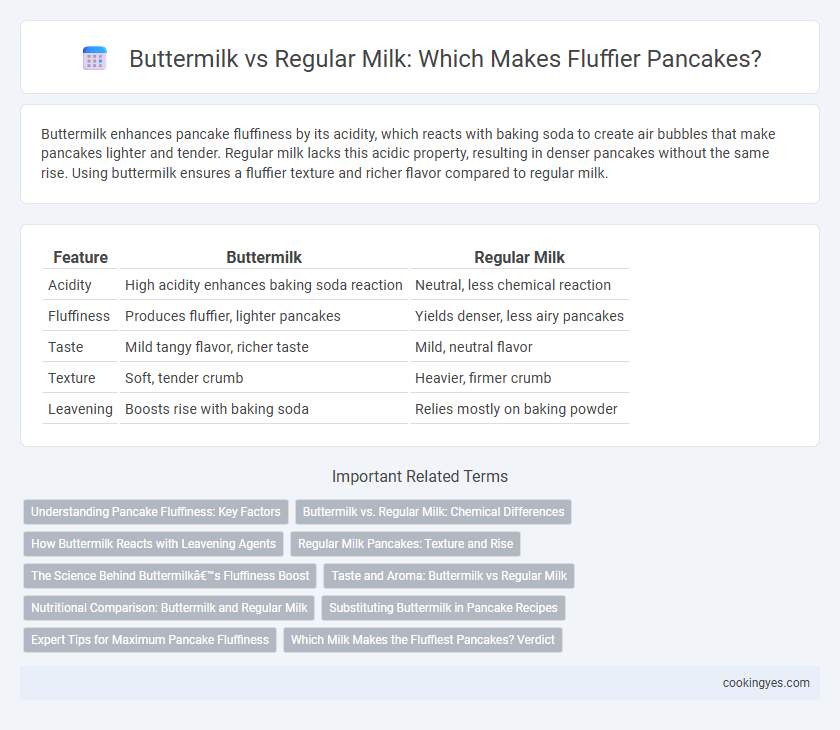Buttermilk enhances pancake fluffiness by its acidity, which reacts with baking soda to create air bubbles that make pancakes lighter and tender. Regular milk lacks this acidic property, resulting in denser pancakes without the same rise. Using buttermilk ensures a fluffier texture and richer flavor compared to regular milk.
Table of Comparison
| Feature | Buttermilk | Regular Milk |
|---|---|---|
| Acidity | High acidity enhances baking soda reaction | Neutral, less chemical reaction |
| Fluffiness | Produces fluffier, lighter pancakes | Yields denser, less airy pancakes |
| Taste | Mild tangy flavor, richer taste | Mild, neutral flavor |
| Texture | Soft, tender crumb | Heavier, firmer crumb |
| Leavening | Boosts rise with baking soda | Relies mostly on baking powder |
Understanding Pancake Fluffiness: Key Factors
Buttermilk enhances pancake fluffiness by reacting with baking soda to produce carbon dioxide bubbles that create a tender, airy texture, unlike regular milk which lacks the acidity needed for this chemical reaction. The higher acidity in buttermilk breaks down gluten more efficiently, resulting in softer, more fluff-filled pancakes. Using buttermilk instead of regular milk is a critical factor in achieving maximum pancake fluffiness.
Buttermilk vs. Regular Milk: Chemical Differences
Buttermilk contains lactic acid, which reacts with baking soda to produce carbon dioxide, resulting in lighter, fluffier pancakes compared to regular milk. Regular milk lacks this acidity, so it doesn't activate baking soda as effectively, leading to denser pancake texture. The chemical difference in pH levels between buttermilk (acidic) and regular milk (neutral) significantly influences the rise and tenderness of pancakes.
How Buttermilk Reacts with Leavening Agents
Buttermilk's acidity reacts with baking soda, producing carbon dioxide bubbles that create a lighter and fluffier pancake texture compared to regular milk. This chemical reaction enhances the rise and tender crumb, preventing dense pancakes often caused by neutral pH milk. Using buttermilk results in pancakes with superior lift and a moist, airy consistency.
Regular Milk Pancakes: Texture and Rise
Regular milk pancakes typically have a lighter texture but less rise compared to buttermilk pancakes due to the lower acidity, which limits the chemical reaction that produces carbon dioxide bubbles. The proteins in regular milk contribute to tenderness, but without the extra acidity, pancakes tend to be slightly less fluffy and more cake-like. Incorporating baking powder or baking soda can help improve rise and fluffiness when using regular milk.
The Science Behind Buttermilk’s Fluffiness Boost
Buttermilk contains lactic acid, which reacts with baking soda to produce carbon dioxide bubbles that create a lighter, airier pancake texture compared to regular milk. The acidity in buttermilk breaks down gluten strands, resulting in a tender crumb and enhanced fluffiness. Regular milk lacks this acidic property, making buttermilk the superior choice for producing soft, fluffy pancakes.
Taste and Aroma: Buttermilk vs Regular Milk
Buttermilk enhances pancake fluffiness by contributing a tangy taste and rich aroma that regular milk lacks, resulting in a more complex flavor profile. The acidity in buttermilk reacts with baking soda, creating air bubbles that improve texture and tenderness. Regular milk produces a milder, less aromatic pancake, yielding a softer but less flavorful bite.
Nutritional Comparison: Buttermilk and Regular Milk
Buttermilk offers a tangy flavor and contains probiotics, calcium, and vitamins B12 and D, which contribute to improved digestion and bone health compared to regular milk. Regular milk provides a balanced amount of protein, calcium, and vitamin D but lacks the beneficial bacteria found in buttermilk. The acidity in buttermilk interacts with baking soda to produce carbon dioxide, enhancing pancake fluffiness while offering additional nutritional benefits over regular milk.
Substituting Buttermilk in Pancake Recipes
Buttermilk's acidity reacts with baking soda to create carbon dioxide bubbles, resulting in significantly fluffier pancakes compared to using regular milk. When substituting buttermilk, mix 1 cup of regular milk with 1 tablespoon of lemon juice or white vinegar and let it sit for 5-10 minutes to mimic the acidity. This effective buttermilk substitute maintains the pancake's tender texture and enhances rise without compromising flavor.
Expert Tips for Maximum Pancake Fluffiness
Using buttermilk instead of regular milk enhances pancake fluffiness due to its acidity, which reacts with baking soda to create carbon dioxide bubbles that lighten the batter. Experts recommend incorporating fresh buttermilk for a tender, airy texture and slightly tangy flavor that regular milk cannot achieve. To maximize fluffiness, mix the batter gently and allow it to rest briefly, ensuring the leavening agents activate properly.
Which Milk Makes the Fluffiest Pancakes? Verdict
Buttermilk creates the fluffiest pancakes due to its acidic properties, which react with baking soda to produce more carbon dioxide bubbles, resulting in a lighter, airy texture. Regular milk lacks this acidity, so pancakes made with it tend to be denser and less tender. For maximum fluffiness and a tender crumb, buttermilk is the preferred choice in pancake recipes.
Buttermilk vs regular milk for pancake fluffiness Infographic

 cookingyes.com
cookingyes.com